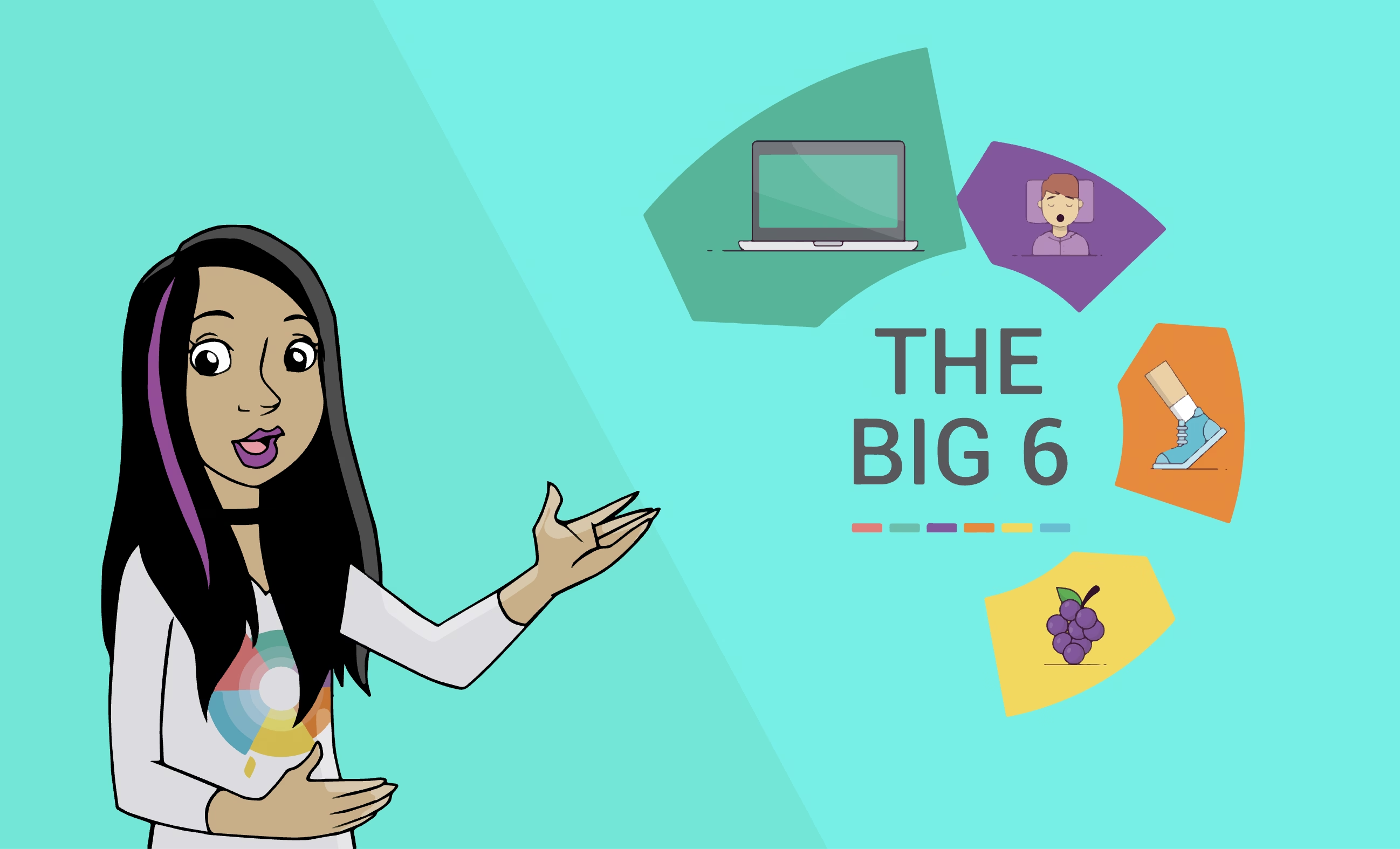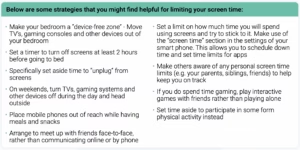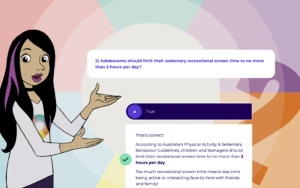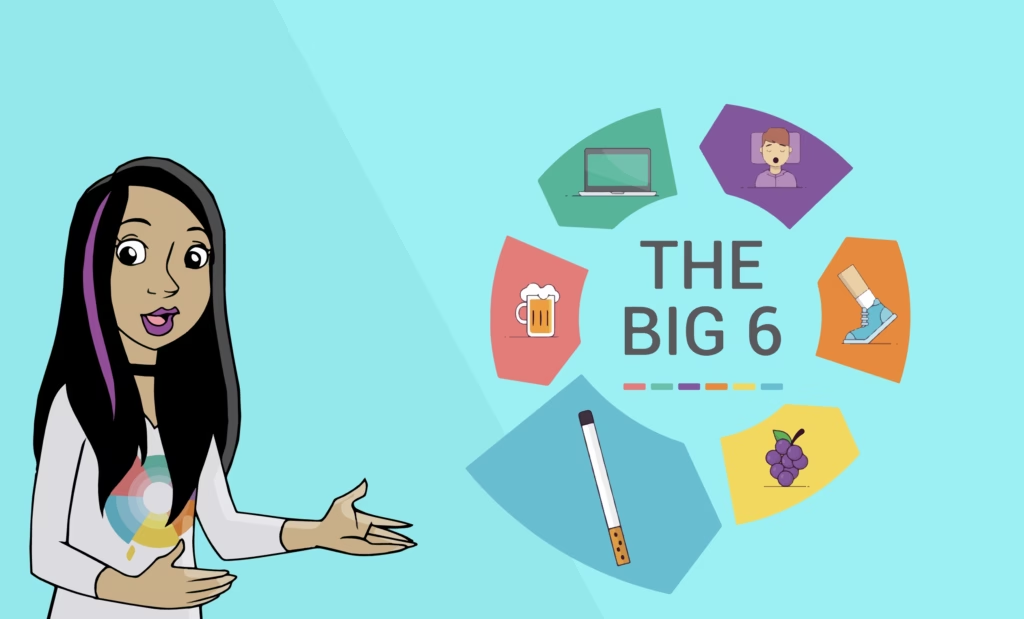
Here we are with the fourth part of our six-part series covering the “Big 6” health behaviours that play an integral role in both the physical and mental health of young people, now and in the long-term [1,2]. These six behaviours are: dietary intake, physical activity, sleep, sedentary recreational screen time, alcohol use and tobacco/e-cigarette use. Read about dietary intake here, physical activity here, and sleep here.
In one of the largest school-based prevention clinical trials in Australia, the Health4Life program found significant associations between each of the Big 6 behaviours and depression, anxiety, and psychological distress symptoms in adolescents [1-3].
This blog post will cover the sedentary recreational screen time component of the Big Six and how it impacts youth mental health.
Firstly, what is sedentary recreational screen time?
Sedentary recreational screen time is time spent sitting using a device, such as mobile phones, computers, video games, tablets, and television, for anything other than school work or educational purposes.
Screen time and mental health in youth
We’re living in a world that’s more connected, wireless, and electronic than ever before, with an ever-growing reliance on screens and devices. Because of this, young people (especially teenagers) are spending an increasing proportion of their time on screens, such as smartphones (the most used device by adolescents), tablets, TVs, and gaming consoles [4].
The Australian guidelines recommend that teenagers limit their recreational screen time to no more than 2 hours per day. However, according to the 2022 Australian Report Card on Physical Activity for Children and Youth, 90% of 12-17 year-olds exceed these guidelines, which can lead to a range of negative consequences. This is also concerning, as the link between screen time and lower psychological well-being has been found to be stronger in adolescents compared to younger children [5].
More time spent on screens, means less time available for physical activity, creative endeavours, hobbies, face-to-face interaction with friends and families, and can disrupt healthy sleep patterns. A 2018 study found that after 1 hour of screen-use a day, subsequent hours of daily screen time were associated with lower psychological wellbeing, less curiosity, lower self-control, more distractability, more difficulty making friends, less emotional stability, and difficulty finishing tasks [5].
Benefits of limiting recreational screen time for adolescents:
- More time for physical activity or sport
- Less exposure to unhealthy foods advertising or other risky behaviours
- Greater belief in yourself and your abilities
- Improved school performance
- Reduced feelings of sadness and worry
- Decreased risk of cyber bullying
The Big 6: Screen time
The 2023 study conducted using the Health4Life data investigated associations between the Big 6 health behaviours and mental health among adolescents in Australia [1,3].
For sedentary recreational screen time, the study found that:
- Young people who kept within 31–60minutes per day faired best, with 22% lower anxiety, 57% lower depression, and 48% lower psychological distress symptoms than those who engaged in eight or more hours per day.
- Perhaps more feasibly in most real life scenarios – those who kept screen time within 1.5–2 hours (meeting the guidelines of ≤ 2 hours per day) still had substantially lower anxiety, depression and psychological distress symptoms.
So, all that being said, how can we address this? Below are some strategies to limit screen time, taken from the student summary of Module 3 in Health4Life.
Strategies to limit screen time

How does the Health4Life program target screen time?
Students work through six cartoon lessons that impart knowledge about improving the Big 6 health behaviours together. The cartoon lessons have been specifically designed for Year 7-8 students, at a time in their lives where many young people are beginning to have greater independence over their lifestyle choices, such as choosing what they eat and how they spend their leisure time. Through engaging, relatable storylines, the Health4Life program covers the guidelines for sedentary recreational screen time and benefits of limiting screen use, negative consequences of excessive recreational screen time and strategies to reduce it, and responsible use of social media.
For example, below is a slide from Lesson 1, where a group of 3 friends have been gaming together. One of the storylines follows Hamish, who often stays up late at night gaming, which has huge impact on his academic performance and social life, as well as his physical health. This also ties into the sleep and physical activity components of the Big 6 as health behaviours are so inter-related.


Here is an example of a multiple-choice activity, which occur throughout the lessons to consolidate students’ knowledge:

The Health4Life program is the first online health education program teaching year 7-8 secondary school students about these Big 6 health behaviours. The program is aligned with the Australian HPE curriculum and the NSW PDHPE syllabus and requires no teacher training and minimal preparation for all class and homework activities. Read more about Health4Life here.
Author: Francesca Wallis
With expert review by researchers at the Matilda Centre for Research in Mental Health and Substance Use.
References:
[1] S. Smout, L. A. Gardner, N. Newton, and K. E. Champion, “Dose–response associations between modifiable lifestyle behaviours and anxiety, depression and psychological distress symptoms in early adolescence,” Australian and New Zealand Journal of Public Health, vol. 47, no. 1, p. 100010, Feb. 2023, doi: https://doi.org/10.1016/j.anzjph.2022.100010.[2] Teesson M, Champion KE, Newton NC, et al, “Study protocol of the Health4Life initiative: a cluster randomised controlled trial of an eHealth school-based program targeting multiple lifestyle risk behaviours among young Australians.” BMJ Open 2020;10:e035662. doi: 10.1136/bmjopen-2019-035662
[3] S. Smout and L. Gardner, “The big six modifiable factors for youth mental health,” InSight+, 2023. https://insightplus.mja.com.au/2023/17/the-big-six-modifiable-factors-for-youth-mental-health/
[4] R. Maria et al., “The associations between screen time and mental health in adolescents: a systematic review,” BMC Psychology, vol. 11, no. 1, Apr. 2023, doi: https://doi.org/10.1186/s40359-023-01166-7.
[5] J. M. Twenge and W. K. Campbell, “Associations between Screen Time and Lower Psychological well-being among Children and adolescents: Evidence from a population-based Study,” Preventive Medicine Reports, vol. 12, no. 12, pp. 271–283, Oct. 2018, doi: https://doi.org/10.1016/j.pmedr.2018.10.003.







